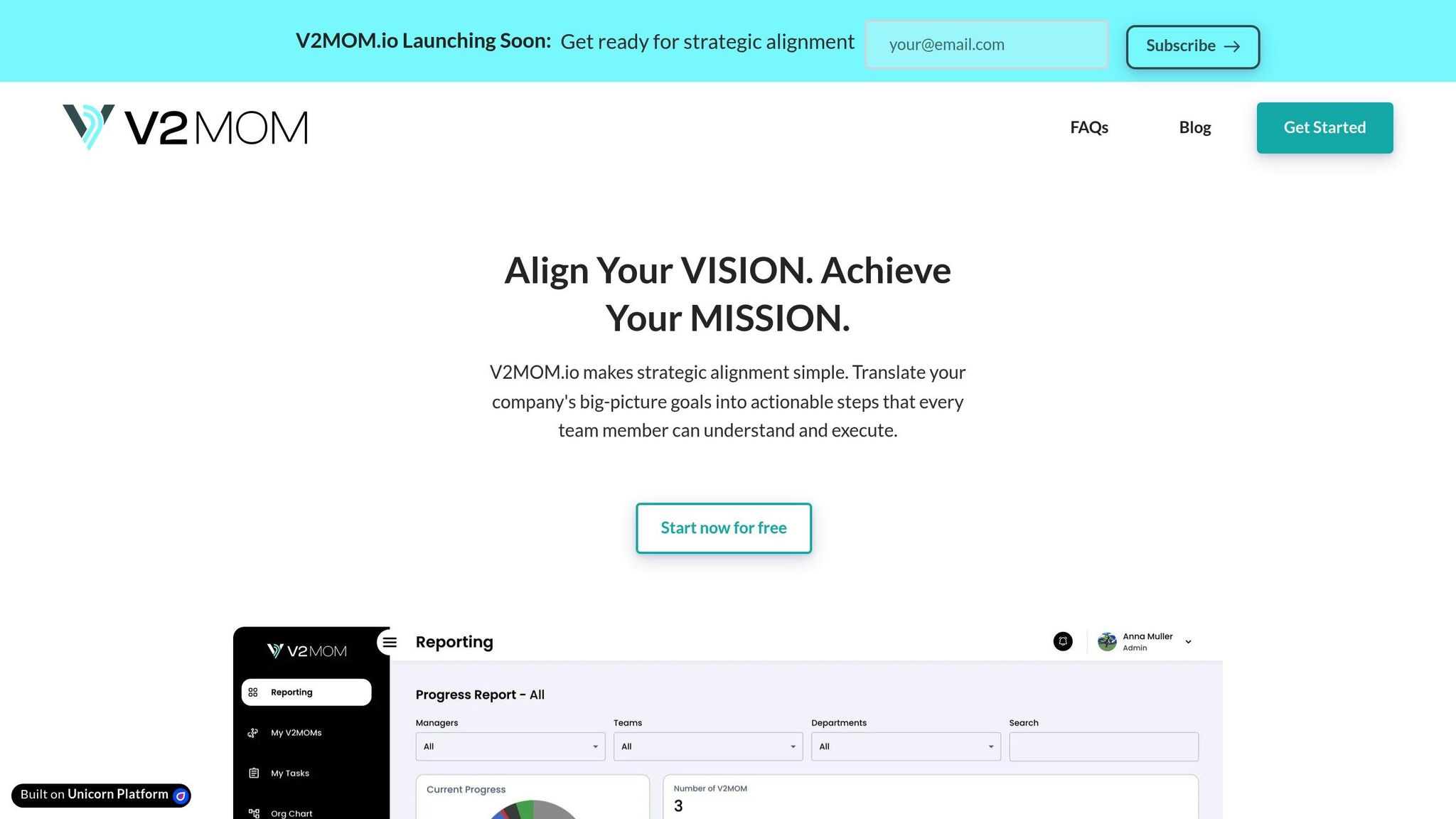Want to make better decisions and boost profits? Start using data. Companies that embrace data-driven decision-making are:
- 23x more likely to gain customers
- 19x more likely to increase profits
- 10% more efficient in operations
This guide breaks down how to:
- Set measurable goals that align with your business vision.
- Collect and analyze accurate data to drive actionable strategies.
- Use tools like V2MOM.io and Tableau to track progress and improve alignment.
- Address challenges like poor data quality and team resistance.
Data-Driven Decision Making Basics
What It Means and Why It Matters
Data-driven decision making (DDDM) changes how organizations plan and act by replacing guesswork with verified data. At its heart, DDDM turns raw data into insights that guide both strategic and day-to-day decisions. This method helps businesses spot opportunities, predict market trends, and fine-tune operations with precision. It's a shift that leads to measurable gains.
Companies using DDDM report making decisions three times more effectively, seeing an average 8% boost in profit and cutting costs by 10% [1][2].
"Data is a force, and that force can turn into something of a burden - or something that truly liberates you, your business and the things that you do. Data, when tamed, can be an asset like nothing else." - Sri Shivananda, SVP and CTO of PayPal [3]
Main Advantages for Companies
Adopting DDDM benefits every part of a business. Here's how top companies use it to stay ahead:
| Benefit | Impact | Real-World Example |
|---|---|---|
| Customer Acquisition | 23x more likely to acquire customers | Netflix uses viewing data to shape content and offer personalized recommendations |
| Profitability | 19x more likely to be profitable | Amazon adjusts pricing and manages inventory with real-time data analysis |
| Operational Efficiency | 10% reduction in overall costs | Starbucks uses analytics to plan store locations and develop products |
These examples highlight how DDDM gives businesses a competitive edge. Between 2023 and 2024, the number of organizations with strong data and analytics cultures doubled from 21% to 43% [4]. But success takes more than just gathering data - it requires a structured approach to using it well. For example, Starbucks analyzes customer data to understand buying habits, allowing them to offer tailored products that strengthen their market position and customer loyalty.
On the flip side, poor data quality costs businesses an average of $12.9 million each year [5]. For companies starting their data-driven journey, building a culture where 73.5% of decisions rely on data is key to long-term success [4].
Data Driven Decisions - Unlocking Business Strategy Success
Building Your Data-Driven Plan
Now that we’ve covered the benefits of data-driven decision-making, let’s outline a plan to turn those insights into actionable strategies.
Set Measurable Goals
Clear, measurable goals are the backbone of any data-driven plan. Avoid vague objectives and focus on specific metrics to track progress effectively.
"The trouble with not having a goal is that you can spend your life running up and down the field and never score." - Bill Copeland [6]
Here’s a framework to help you align your business goals with measurable results:
| Goal Component | Description | Example |
|---|---|---|
| Strategic Focus | Core business objective | Increase market share |
| Measurable Target | Specific numeric goal | 25% growth in active users |
| Timeline | Clear deadline | Q3 2025 |
| Success Metrics | Key performance indicators | Monthly active users, conversion rate |
| Resource Requirements | Tools and team needed | Analytics platform, data team |
Get and Process the Right Data
The right data is key to making informed decisions. For example, a regional bank turned around a decline in high-wealth clientele by fixing inaccurate client data, improving trade execution, and ensuring statement accuracy.
Here’s how to approach data collection effectively:
- Define Objectives: Know what you want to achieve.
- Map Data Sources: Identify where the data will come from.
- Adopt Uniform Standards: Ensure consistency across your data.
Convert Data into Action Steps
Data insights are only useful if they lead to tangible actions. For instance, a large medical center used its data initiatives to reduce compliance costs, improve patient care, and maintain operating margins.
Here’s how to translate insights into action:
- Group findings into themes or patterns.
- Link insights directly to business goals.
- Develop measurable action plans.
- Test changes in controlled settings.
- Track progress and make adjustments as needed.
Keep your plans focused and manageable - aim for a timeline under 36 months. Include specific actions, deadlines, and assign clear accountability to team members [7].
sbb-itb-ee93501
Tools for Planning and Alignment
Using the right tools can make data-driven planning more effective. Modern platforms not only track progress but also help visualize data and ensure teams stay on the same page.
V2MOM.io: Business Alignment Platform

V2MOM.io is built around the V2MOM framework - Vision, Values, Methods, Obstacles, and Measures. It offers features like real-time progress tracking and team collaboration. Pricing starts at $40 per user per month, with an annual billing option reducing it to $3.99 per user per month.
"Success depends on constant communication and complete alignment. We've been able to achieve both with the help of a management process I developed a number of years ago called the V2MOM, which stands for: Vision, Values, Methods, Obstacles, and Measures." – Marc Benioff, Chairman & CEO, Salesforce [8]
This platform organizes strategic planning into five essential components:
| Component | Purpose | Example Application |
|---|---|---|
| Vision | Define clear objectives | Growth targets |
| Values | Set guiding principles | Priority ranking |
| Methods | Outline action steps | Implementation tactics |
| Obstacles | Identify challenges | Resource constraints |
| Measures | Track progress | Quantifiable KPIs |
Data Visualization Tools
Data visualization tools make it easier to turn complex data into actionable insights. Here's a quick look at some popular options:
| Tool | Key Strength | Limitation | Starting Price |
|---|---|---|---|
| Tableau | Advanced mapping features | Steep learning curve | $75/month per user |
| Power BI | Familiar Excel-like interface | Complex table relationships | $10/month per user |
| Looker Studio | Simple and user-friendly | Limited for advanced tasks | Free |
| Klipfolio | Pre-built dashboard templates | Limited free plan | $250/month |
Pairing these tools with platforms like V2MOM.io can improve strategic alignment across teams and departments.
V2MOM.io in Practice

V2MOM.io's structured framework helps teams align their efforts with organizational goals. For example, Salesforce uses the V2MOM approach to ensure every department creates and shares its own plan on the corporate social network. This fosters transparency, encourages communication, and holds employees accountable. Progress is tracked using dedicated tools, ensuring measurable outcomes.
When defining "Measures", applying the SMART framework (Specific, Measurable, Achievable, Realistic, Time-bound) can help set clear success metrics [9].
"The V2MOM enables me to clarify what I'm doing, and then communicate it clearly to the entire company." – Marc Benioff [8]
Regular updates and reviews ensure the V2MOM stays relevant as business conditions change. When combined with strong visualization tools, V2MOM.io becomes a powerful system for planning and execution.
Implementing Your Strategy
Getting your strategy off the ground depends on two key factors: aligning your team and keeping a close eye on performance. It all starts with effective coordination across your organization.
Team Coordination and Buy-in
For a data-driven culture to thrive, everyone on your team needs access to data that’s easy to understand and apply. Research shows that organizations deeply rooted in data are three times more likely to see major gains in decision-making [11].
Here’s how leadership roles play a part in driving change:
| Role Level | Primary Responsibilities | Key Actions |
|---|---|---|
| Executive Leaders | Strategy & Oversight | Set the vision and track outcomes |
| Middle Managers | Implementation | Promote change and guide their teams |
| Team Leaders | Execution | Train team members and address resistance |
To get your team on the same page, focus on these three areas:
- Training: Help your team sharpen their skills in interpreting and using data.
- Access to Quality Data: Make sure the right people have the data they need to make informed decisions.
- Change Management: Identify "fast followers" - team members who can champion new initiatives and create momentum.
Once your team is aligned, the next step is to track performance consistently.
Measuring and Adjusting Plans
With your team engaged, refining your strategy becomes the priority. Regular monitoring and adjustments will keep things on track. For example, hospitals use electronic health records (EHRs) to analyze historical data, predict risk factors, and improve patient care [10].
Here’s how to stay on top of your strategy:
- Set Clear KPIs: Define specific, measurable goals that align with your project’s objectives.
- Use Analytics Tools: Monitor data performance and track KPIs in real time.
- Regular Feedback Loops: Continuously evaluate processes, identify gaps, and make necessary adjustments.
To tackle common challenges during implementation, consider the following solutions:
| Challenge | Solution | Expected Outcome |
|---|---|---|
| Employee Resistance | Appoint change champions | Higher adoption rates |
| Data Silos | Establish governance guidelines | Improved data integration |
| Quality Issues | Conduct regular data audits | More reliable insights |
| Decision Delays | Focus on key metrics | Quicker response times |
Conclusion
Main Points Review
Creating a strategy based on data requires a clear and structured approach focused on measurable results. Organizations that adopt data-driven improvements often experience productivity boosts of 20-30% across their operations [12]. Concentrate on these key components to make a lasting difference:
| Component | Impact | Best Practice |
|---|---|---|
| Data Infrastructure | Lays the groundwork for insights | Use secure and scalable storage systems |
| Goal Setting | Provides direction and focus | Define SMART objectives with clear KPIs |
| Team Alignment | Improves execution | Standardize processes for consistency |
| Performance Tracking | Drives ongoing improvement | Review metrics on a quarterly basis |
These elements are the core of an effective strategy. Now, let’s explore some actionable steps.
Next Steps
To turn these strategic elements into results, follow these proven methods:
Focus on Data Integrity
Ensure data reliability by standardizing collection methods and adding validation checks. For example, the Mayo Clinic revamped its scheduling system, cutting wait times by 35% and improving satisfaction by 28% [12].
Develop a Clear Framework
Create action plans with specific targets and deadlines. As 180ops AI puts it:
"Data is the backbone of strategic decision-making in today's businesses" [13].
Invest in Your Team
Provide ongoing training to enhance data analysis skills. Toyota’s approach to using data-driven methods reduced production defects by 45% - a clear example of how training can pay off [12].
Track and Adapt
Hold regular reviews to measure progress against goals. Tools like V2MOM.io can help you monitor real-time metrics and foster team collaboration [12].


